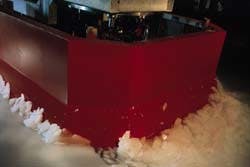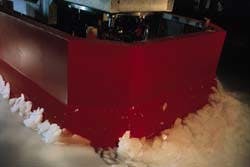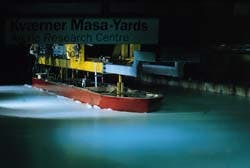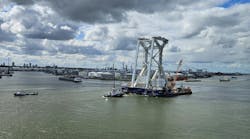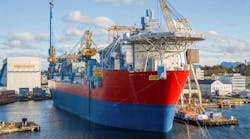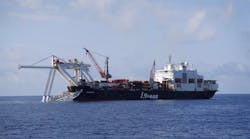The development of the Russian Arctic offshore oil and gas reserves poses a wide range of engineering and economic challenges. It calls for close cooperation with western companies with both developed and developing technologies.
Some of the areas of vital concern are types of structures, underwater pipelines, offloading terminals and tankers. All of which have to be constructed to withstand the effect of low temperatures, ice rubble, moving or mush ice, as well as the forces of ice impact, which can create severe vibrations.
On top of these aspects, there is the increasingly sensitive area of the environment and the effect of producing oil and gas on the ecosystems of the Barents, Pechora, and Kara Seas and Sakhalin Island. There is an absolute requirement for consistent data, as ice conditions can vary dramatically from one year to the next.
Also, there are differing water depths and ice conditions in various areas. Platforms for the giant Schtockmanovskoye gas field in the Barents Sea will need to be ice resistant in water depths of 1,000 ft; Prirazlomnoye in the Pechora Sea lies in 60 ft of water with no multi-year ice, but with two-meter scour from icebergs.
In the Kara Sea depths are around 220 ft and in the Sea of Okhotsk off Sakhalin they are around 150 ft. This compares with an average of 164 ft in Alaska's Cook Inlet and 16-115 ft in the Beaufort Sea and 230 ft off Newfoundland.
Probably no one knows more about every aspect of ice conditions than the Arctic Research Centre (MARC) of Kvaerner Masa-Yards, the Finnish shipbuilding group which has built nearly 100 ice-breakers and Arctic cargo vessels and tankers.
In its 77.3 meter-long test basin, it has performed model studies for potential platforms offshore the north-eastern Sakhalin for a Russian client, for the Lunskoye and Piltun-Astokhskoye Fields. These concentrated particularly on ice being pushed against the structure. Results indicated that the most promising structure could be a monopod-type with a conical shaped water line.
A joint industry field study was made on ice conditions in the Pechora Sea, funded by Amoco, Exxon, Neste, Norsk Hydro, and Texaco. Intensive studies of the possible effect of developments on the ecosystems in this area are continuing.
Studies were carried out on the laying of pipelines across the entrance of Baydarats Bay for the vast Yamal gas developments. There could be risks to these lines from icebergs and also to the bay's shallow water ecology. It may be that they will have to be laid onshore around the bay.
In expectation of the future needs for the technology of advanced tankers, Kvaerner Masa-Yards has studied the development of the optimum Arctic Circle crude oil carrier for the export shuttle service. It also searched for experience in the Russian Arctic fuel trades in order to be ready to offer proven services in the early production phase of the Pechora and Western Siberia field developments.
Mikko Niini of KMY says: "The onshore fields in the Timan-Pechora area could be utilized through a GBS offshore loading terminal, linked to an FSO mooring for tankers, which would most probably be linked quickly with the first shallow water offshore developments. "The fields in Western Siberia have a connection to the Northern Sea route through the Ob and Yenisei Rivers. Gas condensates from these fields are already available for marine transport." KMY has developed an Arctic crude oil/product tanker designed for operation in the shallow coastal waters. It concluded that the maximum practical size is 120,000 dwt. This can operate independently from the Pechora Sea to Rotterdam. A key component is the Azipod propulsion system, which incorporates an electric AC motor inside the pod that directly drives a fixed pitch propeller.
Niini says: "This vessel will have a normal bow construction necessary for seaworthiness in open water, but is fitted with an Azipod installation in order to break ice when going stern ahead. Dynamic positioning at terminals surrounded by ice will take place by the Azipod installation while the ship is linked to the platform through a stern loading arrangement." Special shallow draught ships are being developed for the Ob areas, where the maximum available draught is less than 10 metres.
A great deal of experience is being gained from a KMY/Neste joint venture, Nemarc, which in turn has 34% of Arctic Shipping Service. Russia's Murmansk Shipping holds 49%, with the rest owned by other Russian interests.
Ice-strengthened tankers voyaged further than ever before along Russia's northern sea route in the 1994 July-October sailing season, reaching almost to the Bering Strait, separating Siberia from Alaska. For the first time refined oil products for export were loaded from the shores of the northern sea route.
Two Nemarc 16,000 dwt tankers, the Uikku and Lunni, have been fitted with 11.4MW Azimuth units and have been operational for over a year. Last year Arctic Shipping Services organized the first commercial transportation of condensate from the Ob Bay area in the winter, using the Uikku.
Goran Wilkman, manager of KMY's Arctic Research Centre, says: "The experience of that voyage was that even in the heavy ice conditions of Ob Bay, it is possible with the new technology to perform year-round shipping operations.
"The development of a larger vessel for independent navigation in those shallow water areas is under way and when complete, will solve many of the problems that oil and gas producers in that area have today.
"With the DAT (double acting tanker) concept it is possible to create tankers that can operate in the shallow water areas of the Russian Arctic coast. For many of the potential onshore oil and gas fields, this may be the key to feasibility.
"The long pipelines to be built and maintained on tundra and permafrost are expensive to construct and operate. The marine transportation alternative will be much cheaper in many cases."
(Above) Kvaerner Masa-Yards' Arctic Research Centre performing model tests to measure the effect of ice pushed against a structure with tanker moored alongside. (Left) Double acting tanker tests: the idea was to run the vessel in ice in backing mode, so that the bow can then be designed for open water with only moderate ice breaking capability.
Flexible gas-diesel concept matches FPSO power requirements
North West Europe's current love-affair with floating production has also stoked up interest in the Wartsila gas-diesel concept. Engines are being adapted for four new ship-shaped systems, as well as a semisubmersible and two multipurpose shuttle tankers. FPSO owners want their power production plant to match the multiple functions of their ship or platform, and therein lies the appeal of the Wartsila engines. Aside from proven efficiency and reliability, the gas-diesels can be run on gas (with a 3% pilot of liquid fuel), or entirely on liquid fuel - either MDO, heavy fuel or even crude oil.
Full rated output is available, irrespective of fuel. The gas-diesel engine also allows users to switch from one fuel to another, without interrupting power generation.
In addition, Wartsila gas-diesel engines emit relatively low levels of exhaust gas, which is especially important in Norway, where taxes are imposed on CO2 emissions. From a combustion engine, these emissions are inversely proportional to the engine's efficiency. Thanks to the gas-diesel's very flat efficiency curve, its superiority in this respect is further accentuated in part-load conditions, according to Wartsila Diesel.
Most of the company's current floater orders are for gas-diesels of the standard-size Vasa 32 type. Three are for vessels due to enter service this year.
Smedvig's SPU 380, booked by Esso Norge for the Balder Field, will have storage capacity of 380,000 bbl and production capacity of 50,000b/d. It also incorporates four 16-cylinder Vasa 32s, installed in pairs in two separate engine rooms on the main deck level just forward of the turret. Total installed output is 23,680kW.
The delivery includes complete equipment for gaseous fuel compression designed to match the vessel's process equipment. The fuel gas compressor units comprise multistage water-cooled compressors with associated auxiliaries and control systems, while the two gas compressor units can utilise either of two supply pressures from the vessel's process train.
Astano in northern Spain is close to completing a larger newbuild FPSO for Texaco UK's heavy oil Captain Field. This Tentech 700 design vessel will be able to store 550,000 bbl, with a production capacity of 60,000b/d.
Here five 18-cylinder Vasa 32 gas-diesels are being delivered, specified to run on gas, crude oil and distillate fuel qualities, providing a combined output of 33,300kW. They are being installed in two enclosures on the main deck level in the ship's aft area.
These enclosures are in two separate elevations, with auxiliary equipment such as coolers, pre-heaters, pumps and filters in the lower elevation below the engines. The crude treatment package and the gas compressor packages (comprising two air-cooled compressors feeding into a common manifold for all five engines) are located in the process area.
The third new field installation, but this time for a converted vessel, is BP's Foinaven, west of the Shetlands. Anadyr was originally built by Wartsila Marine in Turku as a submarine repair vessel: Astano is managing the FPSO conversion, which also involves an overhaul of the four existing 16-cylinder Vasa 32 diesels.
These engines, originally used for propulsion, were shipped back to Vaasa for conversion to gas-diesel generating sets. In addition, Wartsila Diesel is supplying four new 18-cylinder gas diesels: all equipment is being installed in engine rooms below the main deck level, with a total installed output of 51,000kW. Two water-cooled reciprocating compressors will be located in the process area on the topside deck, feeding into a common manifold for all eight engines. Two 12-cylinder Vasa 32 gas-diesels have also been ordered by Rasmussen Offshore for a spec newbuild under construction at Mitsui in Japan. This Tentech 700 design will have storage capacity of 550,000 bbl, but at time of writing, the topsides equipment is not finalized as the vessel's location is still open.
Both gas-diesels and one conventional diesel will be stationed in the aft engine room with a further conventional diesel engine in the forward engine room (both rooms being below deck level).
Planning ahead
Wartsila Diesel can still supply conventional diesel engines with provision for conversion into gas-diesels at a later point. When this switch is considered as an option from the outset, some gas-diesel related engine components will already be fitted on the engine, along with bores, machining and piping connections.
When the decision to finally convert is made, a smooth changeover is vital while the ship or platform is in production. But with the engines already prepared for their new duties, basically only auxiliary equipment needs to be added. This minimizes engine downtime. As an example, two multipurpose shuttle tankers are currently under construction at Samsung in Korea for Statoil. Each will be equipped with four six-cylinder versions of the larger Wartsila 46 engine type.
These tankers are being designed from the outset for easy conversion into FPSOs. Consequently, the engines are specified with provision for later conversion into gas-diesels. The machinery concept matches the multipurpose ship design and does not restrict any future plans.
Conversion is also possible on existing semisubmersible production platforms. Statoil's Veslefrikk B semi was originally a drilling rig built by Daewoo in Korea in 1985. Today it can produce oil at up to 63,000b/d.
The platform features eight 12-cylinder Vasa 32s located in two engine rooms below the main deck level. Last year Wartsila Diesel was contracted to convert two of the installed engines to gas-diesels. This had to be performed onboard without disturbing normal production.
The conversion was carried out by a dedicated team of service engineers from the company's Vaasa factory, who also updated some other components. Total output of these two engines is now 8,150kW. For gaseous fuel handling equipment, Statoil opted for a water-cooled compressor unit feeding both gas-diesels. The compressor unit is located on deck in the process area.(Top) Efficiency of the Wartsila gas-diesel compared to conventional engines. (Bottom) Wartsila Diesel can also convert existing engines to gas-diesels, as was the case last year on the Veslefrikk B semi.
Valves supplied by Larox have been installed in pneumatic conveying lines and bulk tank discharge facilities on the Smedvig-owned North Sea drilling rig West Vanguard.
The valves are employed in a system consisting of three bulk mud and three 90 cu m bulk cement storage tanks. The flowing medium is dry cement for molding casings in the drilling wells and the other application containing barite and bentonite which are transported to the mud processing area. Occasionally, the cement flow also contains silica, which is know to cause problems of wearing in metallic valves.
The bulk material is transported through the pipelines by means of 4bar air pressure, the system capacity being approximately 120 ton/hr. Product flow is extremely abrasive and aggressive, so the process conditions set very high standards for the operating valves. The most critical valve application is the discharge control of the storage tanks. Prior to installation of the Larox products, the valves used wore out following only a few cementation processes.
Larox's representative in Norway, Brevik Process, engineered a solution for the West Vanguard which involved hydraulically operated control valves. Following the installation, operating time has lengthened four to five times over what was achieved with the previous valves.
Maintenance is also simple: the new valves require merely a sleeve change instead of a complete repair. This sleeve is an inexpensive spare part which can be changed easily without special tooling. Following this experience, the rig's previously used butterfly and special build stellite coated valves were also replaced by Larox hydraulic and manually-operated valves. In the UK North Sea, Larox has supplied valves to drilling platforms operated by Elf, Chevron, Total and Shell. Lower capital costs, better delivery and ease of maintenance helped clinch these jobs, according to Larox.
Larox valves withstand rigors of North Sea well cementation
Copyright 1996 Offshore. All Rights Reserved.
